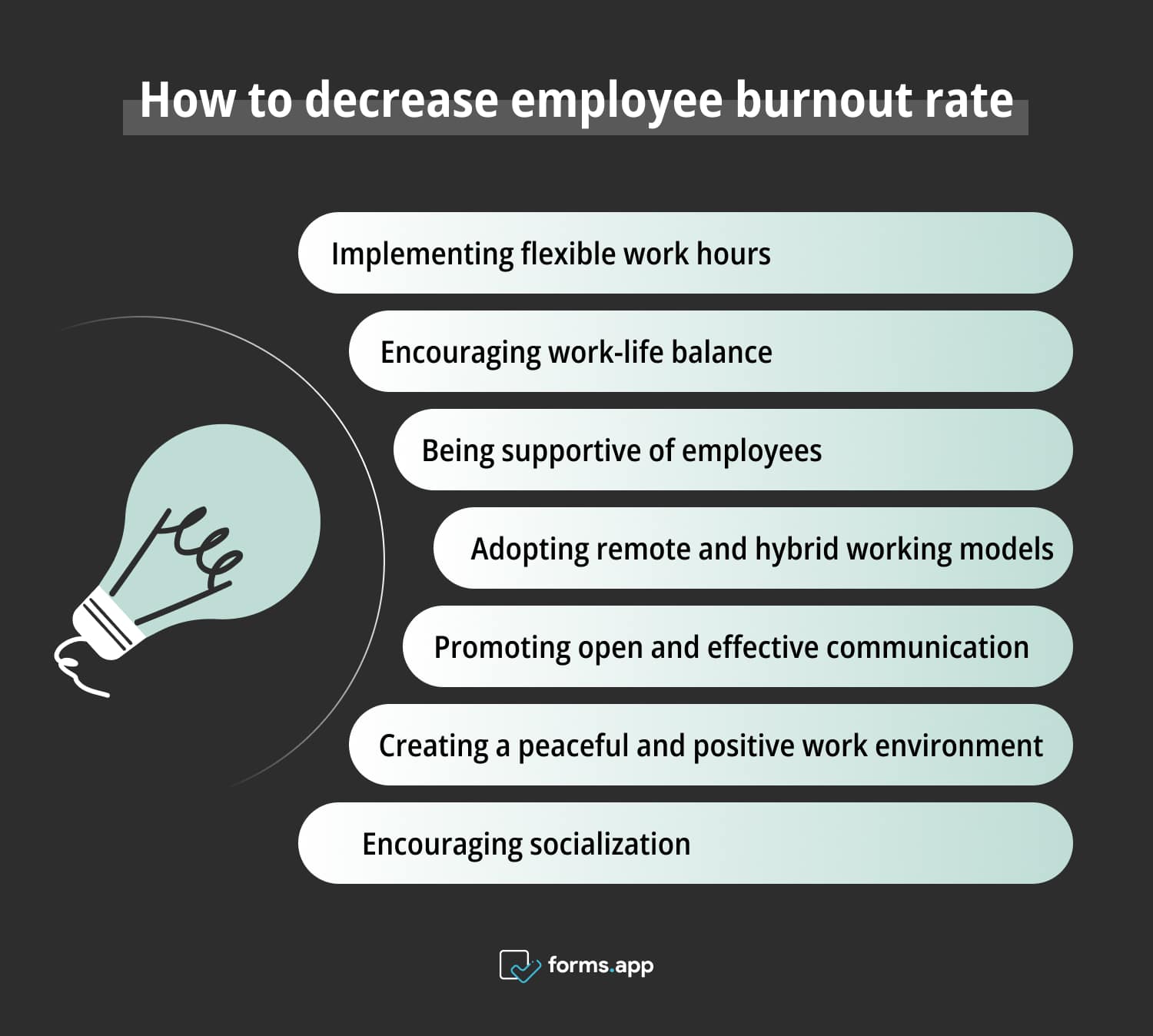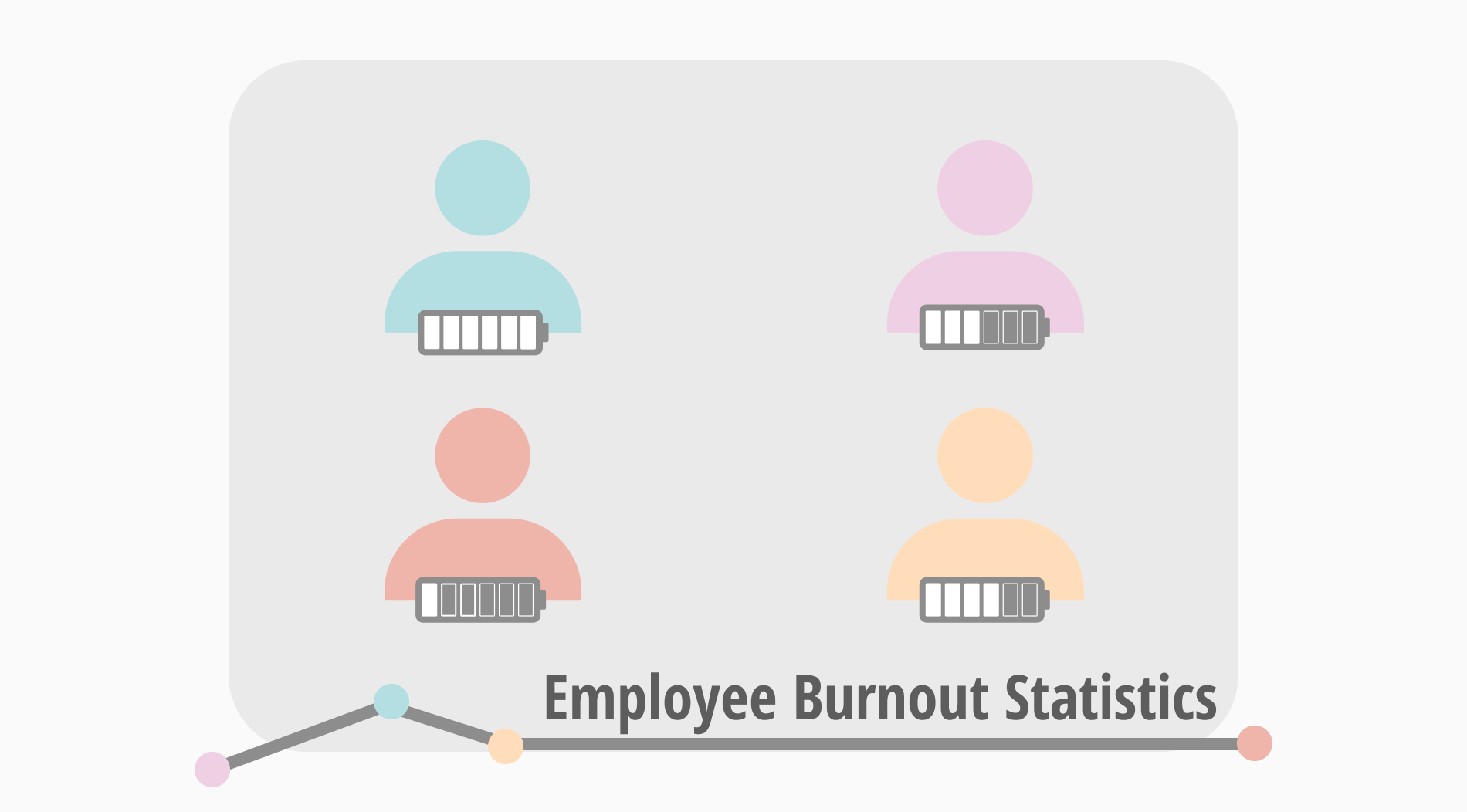The increasing pressure and expectations on employees in today's business world have led to the emergence of work-related stress and burnout. Work-related burnout negatively affects the physical and mental health of employees and reduces their quality of life. Employers and managers have a great responsibility in this regard.
Caring about the mental health of employees is the first thing employees should do to prevent work-related burnout. We have compiled 20+ employee burnout statistics for you. With our workplace burnout statistics, you will learn how to ensure employee satisfaction and prevent burnout in your company. Without wasting any more time, let's move on to our article that will guide you:
Possible causes of workplace stress
Preventing work-related burnout is essential for both the mental health of employees and the success of companies. Employees who do not feel burnout and work-related stress tend to be more motivated and productive. This contributes to the success of companies. Some of the factors that increase workplace stress are as follows:
- Long working hours
- Unbalanced workload
- Lack of support
- Financial insecurities
- Inability to achieve work-life balance
- Feeling of inadequacy
- Failure to communicate correctly
20+ Eye-opening employee burnout statistics
A stress-free working environment ensures employee satisfaction and increases employee loyalty to the company. Thanks to the 20+ burnout syndrome statistics and employee feedback statistics, you will learn the subject in detail. You will also learn about the factors that cause burnout and how to prevent it. Now, let's move on to our 20+ valuable employee burnout statistics worldwide:
1. Burnout experienced at work can lead to serious mental health problems.
Calm's Voice of the Workplace Report revealed an enlightening statistic on the mental health of the surveyed employees. According to them, 68% of employees reported having difficulty getting asleep within the preceding month, and 61% stated they felt depressed, down, or hopeless.
Workplace stress doesn't just negatively affect mental health, it can also manifest in physical symptoms. These can include sleep disturbances, chronic fatigue, and even shortness of breath. Stress can also lead to depression and demoralization. It's crucial for employers to take employee burnout seriously and implement preventive measures.
2. Employees who are not supported by their managers are more likely to feel burnout.
Managers' communication with employees is the key to a stress-free work environment. ThriveMyWay’s eye-opening statistics show that burnout is 70% more common in employees who feel their managers are not supporting them. This underscores the crucial role managers play in preventing burnout.
Employees need to feel supported and valued in order to be motivated and feel a sense of belonging to the company. In this regard, the support they receive from their managers plays an important role in coping with job stress.
3. Work-life balance is important for employees' mental and physical health.
One of the most significant factors contributing to employee burnout is that they think they should always be accessible for work. The results of a survey by Calm show that nearly 6 of 10 global workers agree that they are constantly connected for work.
The feeling that they need to be constantly available makes it impossible for employees to achieve work-life balance. Achieving work-life balance is essential for employees' physical and mental health as well as their productivity. For this reason, the measures managers take to ensure their employees' work-life balance also affect the success of companies.
4. 81% of employees want to work in companies where their mental health is cared for.
Companies that support mental health and provide a peaceful work environment for their employees are favored among job applicants. Statistics from the American Psychological Association provide further proof for this. According to their data, 81% of respondents stated they would search for businesses supporting mental health when looking for job opportunities.
Caring about your employees' mental health and taking measures to improve it makes them feel valued and increases their loyalty. Ensuring employee satisfaction also contributes to your company's success by increasing their productivity. By preventing stress and burnout in your company, you can encourage potential employees to choose your company.
5. Heavy workload increased stress levels in nearly half of the employees.
In its survey, Statista revealed the link between heavy workloads and employee burnout. Nearly 50% of the employees surveyed in 2021 said that having a heavy workload increased their stress levels at work. More than one-third also stated that their stress at work increased as a result of having difficulty achieving work-life balance.
Employee burnout is an inevitable consequence for those who struggle to achieve a work-life balance. As an employer, it's crucial to recognize that helping your employees find this balance is not just a matter of their well-being. It is also a key factor in your company's success.
6. Stress and depression are thought to cause 12 billion lost working days.
Burnout in the workplace reduces employee productivity and causes a loss in the workforce. World Health Organization burnout statistics reveal the seriousness of this situation. They revealed that anxiety and depression are thought to cause 12 billion lost working days annually worldwide, costing $1 trillion in lost productivity.
Work-related burnout leads to anxiety and depression. As you can see from the statistics above, the adverse effects of anxiety and depression experienced by employees on companies are also huge. Therefore, supporting the mental health of your team members and working to reduce their stress will help your company grow.
7. Only half of employers care about the mental health of their employees.
According to Fortune, nearly 82% of employees are at risk of burnout in 2024, yet only half of employers are planning with their employees' mental health in mind. This statistic tells you that employers do not take the risk of employee burnout and mental health as seriously as they should.
The fact that almost 82% of employees are at risk of burnout shows that this situation is even more widespread than previously thought. However, employers and managers should take the risk of burnout more seriously. In this way, employee satisfaction can be ensured, and a more productive working environment can be achieved.
8. Work-related burnout increased by 8% in the last quarter of 2022.
Future Forum proves that globally, the percentage of people experiencing burnout increased to 40% in the fourth quarter of 2022, up 8% from May. The United States saw the most increase in burnout, with 43% of desk workers reporting experiencing it. Younger employees are also more likely to experience burnout. 49% of employees aged 18-29 say they feel burned out.
Increasing competition in almost every sector increases the pressure on employees every year. Increasing workload and working hours increase the feeling of job-related burnout. The solution to the high levels of burnout, which is seen in different amounts in different age groups, is obvious. The most prominent solution is for employers to support employees and care about their mental health.
9. 66% of Gen Z reported feeling depressed due to high levels of stress at work.
The Calm 2024 Voice of the Workplace Report revealed the rates at which different generations experience work-related stress. 66% of Gen Z reported feeling depressed or down due to high levels of work-related stress. This rate is 50% in Gen X and Baby Boomers.
Work-related stress and burnout have significant negative consequences for both themselves and the companies they work for. It adversely affects both the physical and mental health of employees and reduces their quality of life. For companies, it reduces work productivity and negatively impacts the work environment. This is why you should help your employees successfully manage stress.
10. Flexible working hours reduce stress.
Flexible working hours have led to lower stress levels among employees. Future Forum shows that employees with full schedule flexibility report being 29% more productive and 53% more able to concentrate than those without this option. Furthermore, policies that allow for flexible remote work were listed as the main reason company culture has improved in the last two years.
Flexible working hours are a very important factor for employees to balance work and life. Achieving a successful work-life balance reduces burnout and the negative effects of stress and increases employee satisfaction. It would be best to consider remote and hybrid working models to prevent your employees from feeling work-related burnout.
11. Work-related burnout can lead to anxiety.
Work-related burnout can lead to serious mental illness. One of these illnesses is anxiety. According to a June 2023 Statista survey, anxiety was reported by 60% of American workers who had reached a high degree of burnout in the previous year.
Communicating well with your employees and making them feel that you care about them can reduce burnout and anxiety. Finding solutions to increased mental distance and building strong bonds with them will prevent such issues. With correct communication and strong bonds, your employees will be more productive for your company.
12. Burned-out employees are 63% more likely to take a sick day.
A Gallup study revealed the negative situations a company can face when its employees experience burnout. Burned-out employees are 2.6 times more likely to be actively looking for a new job and are 63% more likely to take a sick day. Even if they do stay, their performance confidence is usually 13% lower.
Stress and burnout are some of the biggest causes of absenteeism at work. In addition, high levels of stress will weaken the immune system, leading to higher rates of sick days. Maintaining your employees' mental and physical health is only possible by providing them with a stress-free working environment.
13. Almost 1 in 4 employees experience high or very high levels of burnout.
Statista revealed critical data on the levels of burnout among workers in the United States. According to a June 2023 survey, 22% of American workers said they were currently at a high or very high level of burnout. With nearly one in four workers in the United States suffering from severe burnout levels, employers have a lot of work to do.
Factors such as long working hours, heavy workloads, and poor relationships can lead to work stress and burnout. It is up to managers to address such factors and create a more peaceful work environment for employees. Preventing workplace stress and burnout will benefit both employees and employers in the long run.
14. Work-related burnout drives employees to change jobs.
The American Psychological Association's statistic on workers considering job changes due to workplace stress is a wake-up call. It proves that employees who experience stress during work days are over three times more likely to seek employment elsewhere in the upcoming year.
This valuable statistic underscores the urgent need for employers to address chronic workplace stress and prioritize employee well-being. The importance you give to your employees' mental health will increase their satisfaction and loyalty to your company. In this regard, you need to ensure flexible working hours and a balanced distribution of workload.
15. 59% of employees prefer companies where mental health is supported when looking for a new job.
Westfield Health has released a statistic that shows how important mental health is to employees' job choices. According to their survey, mental health is a significant motivator for 59% of employees to look for a new position.
Companies that pay more attention to the mental health of their employees are one step ahead of their competitors. Caring about their mental health improves the satisfaction of your employees and encourages them to continue working with you. In this way, you can create a healthy working environment by preventing stress and burnout.
16. Managers have a more significant impact on employees' mental health than previously thought.
The impact of managers and employers on employees' mental health is profound, as confirmed by Calm's latest survey. A staggering 65% of employees believe that a supportive and caring manager can significantly improve their mental well-being. Conversely, a manager who causes stress can have a detrimental effect.
This statistic underscores the crucial role managers play in fostering a healthy work environment. The way you treat your employees at work can make them feel more valued, which in turn motivates and commits them to their work. Being made to feel valued by their employers and managers also increases their sense of belonging to the company.
17. 36% of employees think their company does not take any measures against burnout.
According to Eagle Hill Consulting, 36% of employees think that their company is not doing anything to address employee burnout. On the other hand, 34% feel that their company's increasing flexibility in work hours, and 26% believe there is an improvement in communication.
More than one in three employees feel that their company does not care about their burnout, which is a warning for employers. Companies that do not care about their employees' mental health are doomed to fail because they cannot ensure productivity. Therefore, preventing employee burnout should be a priority for employers.
18. Only 1 in 5 employees receive support from their company about burnout.
FlexJobs has revealed a shocking statistic that shows how seriously companies take employee burnout. According to FlexJobs, only 21% of respondents claim to have open and productive discussions with HR regarding burnout relief. On the other hand, 56% said that their HR departments did not encourage conversations about their burnout.
This statistic shows that the vast majority of companies fail to support the mental health of their employees. However, the psychological and physical health of employees who were encouraged to communicate accurately and openly in the workplace significantly improved.
19. Income level affects the rate at which employees experience burnout.
ThriveMyWay found that employee burnout rates vary slightly depending on income levels. Mid-level earners earning between $30,000 and $60,000 had the most significant reported burnout rate at 44%. The lowest burnout rate was in the $100,000 and above bracket with 38%.
The fact that income level affects the burnout rate of employees confirms that financial imbalances are one of the most crucial stress factors. Employees who feel more financially secure generally have lower rates of burnout. Employers who want to reduce work stress and protect employees from burnout should make them feel financially secure.
20. Financial factors and overwork are the most significant factors driving employees to burnout.
There may be many factors that lead employees to stress and burnout at work. Calm's Voice of the Workplace Report shows that the top three mental health stressors in 2024 are cost of living/inflation, financial instability, and overwork. Addressing all these factors separately provides employees with a more peaceful working environment.
Measures should be taken to prevent factors that lead employees to burnout, such as overwork. One of these measures is to give importance to employees' work-life balance. In this way, you will make your employees more productive and create a better working environment for your company.
💡If you are curious about remote work statistics, check out our article for further information!
How can you decrease employee burnout rate?
Paying attention to the mental health of your employees and preventing burnout will enable a positive working environment. Your employees' commitment to work will increase, and employee costs will decrease. In addition, an increase in productivity will be observed by ensuring employee satisfaction. Here are some of the points you should pay attention to reduce the burnout rate:

Ways to decrease employee burnout rate
- Implementing flexible work hours
- Encouraging work-life balance
- Being supportive of employees
- Adopting remote and hybrid working models
- Promoting open and effective communication
- Creating a peaceful and positive work environment
- Encouraging socialization
Key points to take away
To summarize, supporting your employees' mental health and keeping them away from burnout is one of the most important factors in your company's success. The 20+ employee burnout statistics we have prepared for you will guide you in this regard. By identifying the factors that lead your employees to burnout, you will prevent them and ensure employee satisfaction.
Now that you know how to create a more positive work environment for your employees, you are ready to grow your company!
forms.app, your free form builder
- Unlimited views
- Unlimited questions
- Unlimited notifications



